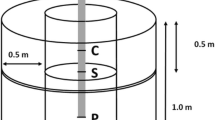Abstract
In New Zealand poplars are commonly planted on moist, unstable pastoral hill country to prevent or reduce soil erosion, thereby maintaining hillslope integrity and pasture production. Mechanical reinforcement by poplar root systems aids slope stabilisation. Root mass and distribution were determined for three Populus deltoides × nigra ‘Veronese’ trees aged 5, 7 and 9.5 year planted as 3 m poles at 8 m × 8 m spacing on a hillslope near Palmerston North in the southern North Island. Most of the structural roots (≥2 mm diameter) were distributed in the top 40 cm of soil. Vertical roots penetrated to about 1.0 m, being the depth of the soil above a fragipan. Total structural root dry masses (excluding root crown) were 0.57, 7.8 and 17.90 kg for the trees aged 5, 7 and 9.5 year, respectively. Total structural root length was 79.4 m for the 5 year tree and 663.5 m for the 9.5 year tree. Surrounding trees were estimated to increase root mass density to 3 times and root length density to 4–5 times the contribution of the single tree at 9.5 year. The study indicated that root development of wide-spaced poplar trees on hillslopes was minimal in the first 5 years but then increased rapidly. These results suggest that poplar trees established from poles may take at least 5 years to develop a structural root network that will effectively bind soil.




Similar content being viewed by others
References
Abernethy B, Rutherfurd ID (2001) The distribution and strength of riparian tree roots in relation to riverbank reinforcement. Hydrol Process 15:63–79
Burgess PJ, Nkomaula JC, Medeiros Ramos AL (1997) Root distribution and water use in a four-year old silvoarable system. Agroforestry Forum 8:15–18
Coleman MD, Dickson RE, Isebrands JG (2000) Contrasting fine-root production, survival and soil CO2 efflux in pine and poplar plantations. Plant Soil 225:129–139
Davis GR, Neilsen WA, McDavitt JG (1983) Root distribution of Pinus radiata related to soil characteristics in five Tasmanian soils. Aust J Soil Res 21:165–171
Di Iorio A, Lasserre B, Scippa GS, Chiatante D (2005) Root system architecture of Quercus pubescens trees growing on different sloping conditions. Ann Bot 95:351–361
Douglas GB, Walcroft AS, Hurst SE, Potter JF, Foote AG, Fung LE, Edwards WRN, van den Dijssel C (2006a) Interactions between widely spaced young poplars (Populus spp.) and introduced pasture mixtures. Agrofor Syst 66:165–178
Douglas GB, Walcroft AS, Hurst SE, Potter JF, Foote AG, Fung LE, Edwards WRN, van den Dijssel C (2006b) Interactions between widely spaced young poplars (Populus spp.) and the understorey environment. Agrofor Syst 67:177–186
Ekanayake JC, Marden M, Watson AJ, Rowan D (1997) Tree roots and slope stability: a comparison between pinus radiata and kanuka. NZ J For Sci 27:216–233
Friend LA, Scarascia-Mugnozza G, Isebrands JG, Heilman PE (1991) Quantification of two-year-old hybrid poplar root systems: morphology, biomass, and 14C distribution. Tree Physiol 8:109–119
Gray DH, Leiser AJ (1982) Biotechnical slope protection and erosion control. Van Nostrand Reinhold, New York, pp 271–278
Hawley JG, Dymond JR (1988) How much do trees reduce landsliding? J Soil Water Conserv 43:495–498
Hewitt AE (1998) New Zealand soil classification. Landcare Research Science Series No. 1, 2nd edn, 133 pp
Kellman M (1979) Soil enrichment of neotropical savanna trees. J Ecol 67:565–577
McIvor IR, Douglas GB (2005) Development of soil cohesion during a decade of growth of poplars on steep erodible slopes in the southern Ruahine Ranges. http://www.sluri.org.nz/index/members/52
McIvor IR, Metral B, Douglas GB (2005) Variation in root density of poplar trees at different plant densities. Proc Agron Soc NZ 35:66–73
Morgan RPC, Rickson RJ (1995) Conclusions. In: Morgan RPC, Rickson RJ (eds) Slope stabilisation and erosion control: a bioengineering approach. E & FN SPON: Chapmann & Hall, London, 274 pp
Puri S, Singh V, Bhushan B, Singh S (1994) Biomass production and distribution of roots in three stands of Populus deltoides. For Ecol Man 65:135–147
Sands R, Bowen GD (1978) Compaction of sandy soils in radiata pine forests. II. Effects of compaction on root configuration and growth of radiata pine seedlings. Aust For Res 8:163–170
Tomlinson H, Traore A, Teklehaimanot Z (1998) An investigation of the root distribution of Parkia biglobosa in Burkina Faso, West Africa, using a logarithmic spiral trench. For Ecol Man 107:173–182
Waldron LJ, Dakessian S (1981) Soil reinforcement by roots: calculation of increased soil shear resistance from root properties. Soil Sci 132:427–435
Wall AJ, Mackay AD, Kemp PD, Gillingham AG, Edwards WRN (1997) The impact of widely spaced soil conservation trees on hill pastoral systems. Proc NZ Grassland Assoc 59:171
Watson A, O’Loughlin C (1990) Structural root morphology and biomass of three age classes of Pinus radiata. NZ J For Sci 20:97–110
Watson A, Phillips C, Marden M (1999) Root strength, growth, and rates of decay: root reinforcement changes of two tree species and their contribution to slope stability. Plant Soil 217:39–47
Wilkinson AG (1999) Poplars and willows for soil erosion control in New Zealand. Biomass Bioenergy 16:263–274
Wilson BF (1975) Distribution of secondary thickening in tree root systems. In: Torrey JG, Clarkson DT (eds) The development and function of roots. Academic Press, 618 pp
Wu TH, Beal PE, Chinchun L (1988) In-situ shear test of soil-root systems. J Geotech Eng 114:1377–1393
Acknowledgements
Thanks to several visiting scientists and students involved in the excavations and measurements. Alistair Hall provided the analytical solution for measuring the contribution of surrounding trees to the root density in the space surrounding a single tree. Excavation of the tree aged 9.5 year and this paper were funded by the Soils and Land Use Research Initiative, FRST programme C02X0405.
Author information
Authors and Affiliations
Corresponding author
Rights and permissions
About this article
Cite this article
McIvor, I.R., Douglas, G.B., Hurst, S.E. et al. Structural root growth of young Veronese poplars on erodible slopes in the southern North Island, New Zealand. Agroforest Syst 72, 75–86 (2008). https://doi.org/10.1007/s10457-007-9090-5
Received:
Accepted:
Published:
Issue Date:
DOI: https://doi.org/10.1007/s10457-007-9090-5




